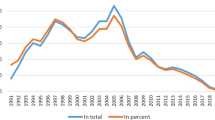Abstract
The objective of this paper is to examine the main changes in the metropolitan labor markets associated with economic restructuring in Mexico during the late 1980s and beginning of the 1990s. The analysis refers particularly to the four largest metropoles of the country, Mexico City, Guadalajara, Monterrey and Puebla, looking for common characteristics in their emergent employment structures now strongly differentiated in terms of rewards, stability in employment relations and conditions of access to jobs. The analysis reveals that largest metropolitan areas have been the most profoundly affected by the economic restructuring resulting from globalization, through a rapid de-industrialization and the expansion of the tertiary sector. Metropolitan labor markets in Mexico, at the time that show signs of social polarization in the formal sector, put in evidence a general process of precarization – less labor stability, replacement of permanent by part-time jobs, and increasing subcontracting –, segmentation of the labor force, and an increasing informal conditions of economic activities with small businesses and unskilled, temporarly and poorly paid jobs. The labor force segmentation and its more precarious and casual conditions are mostly explained by the impact of recent neoliberal policies, and recurrent economic crisis during the 1980s and 1990s which highly contributes to social inequality.
Similar content being viewed by others
References
Aguilar, A.G.: The Urban Labor Market in Mexico: Global Change, Informality, and Social Polarization. Urban Geography, (1997) (forthcoming).
Aguilar, A.G.; Rodriguez, F.: The Dispersal of Urban Growth in Mexico, Regional Development Studies, 1–26 (1995).
Bravo, L.: La Apertura Comercial 1983–1988. Contribución al Cambio Estructural de la Economía Mexicana. In: Bazdresch, C. et al. (eds.), México, Auge, Crisis y Ajuste, Fondo de Cultura Económica, México. 1993.
Castells, M.: The Informational City, Blackwell, Oxford. 1989.
Coffey W.J.: The ‘Newer’ International Division of Labor. In Daniels, P.W.; Lever, W.F. (eds.), The Global Economy in Transition, Longman. 1996
CONAPO: Sistema de ciudades y distribución espacial de la pobla ción en México. Consejo Nacional de Población, México. 1991.
Drakakis-Smith, D.: Less Developed Economies and Dependence. In: Daniels, P.W.; Lever, W.F. (eds.), The Global Economy in Transition, Longman. 1996
Dussel, E.; Kim, K.: From Trade Liberalization to Economic Integration: The Case of Mexico. Working Paper No. 187, The Helen Kellogg Institute for International Studies, University of Notre Dame, USA. 1993.
Fainstein, S.; Harloe, M.: Introduction: London and New York in the contemporary world. In: Fainstein, S.; Gordon, Y.; Harloe, M. (eds.), Divided Cities. Blackwell, Oxford, 1992.
Friedmann, J.; The World City Hypothesis, Development and Change, Vol. 17, 69–83 (1986).
Friedmann, J.: Where we stand: a decade of world city research. In: Knox, P.L.; Taylor, P.J. (eds), World Cities in a World-System, p. 21–48. Cambridge University Press 1995.
Hamnett, Ch.: Social Polarization in Global Cities: Theory and Evidence. Urban Studies 31,3, 401–424 (1994a).
Hamnett, Ch.: Socio-Economic Change in London: Professionalization not Polarization, Built Environment 20(3), 192–203 (1994b).
Hamnett, Ch.: Why Sassen is Wrong: A Response to Burgers. Ur ban Studies 33,1, 107–110 (1996).
Infante, R.; Klein, E.: Mercado Lationamericano del Trabajo en 1950–1990. Revista de la CEPAL, Vol. 45, 129–144 (1991).
Marcuse, P.: Dual City: A Muddy Metaphor for a Quartered City. International Journal of Urban and Regional Research 13,4, 697–708 (1989).
OCDE; Estudio Económico de la Organización para la Coopera ción y el Desarrollo Económicos (OCDE). México, El Trimestre Económico, LXII,4, 248, 555–616 (1995).
Pinch, S.: Social Polarization: A Comparison of Evidence from Britain and The United States. Environment and Planning A, 25, 779–795 (1993).
Rivera, M.A.: La Nueva Crisis de la Economía Mexicana. Investigaciones Económicas LVI, 216, 51–84 (1996).
Safa, H.: Urbanization, the Informal Economy and State Policy in Latin America. In: Smith, M.P., Feagin, J.R. (eds.) The Capitalist City, Basil Blackwell, Oxford, 1987.
Sassen, S.: The Global City: New York, London, Tokyo. Princeton, NJ., Princeton University Press. 1991.
Timberlake, M.; Lunday, J.: Labor Force Structure in the Zones of the World Economy, 1950–1970. In: Timberlake, M. (ed.), Urbanization in the World Economy, Academic Press, 1985.
Van Kempen, E.T.: The Dual City and The Poor: Social Polarization, Social Segregation and Life Chances. Urban Studies 31,7, 995–1015 (1994).
Author information
Authors and Affiliations
Rights and permissions
About this article
Cite this article
Aguilar, A.G. Metropolitan growth and labor markets in Mexico. GeoJournal 43, 371–383 (1997). https://doi.org/10.1023/A:1006895907459
Issue Date:
DOI: https://doi.org/10.1023/A:1006895907459




